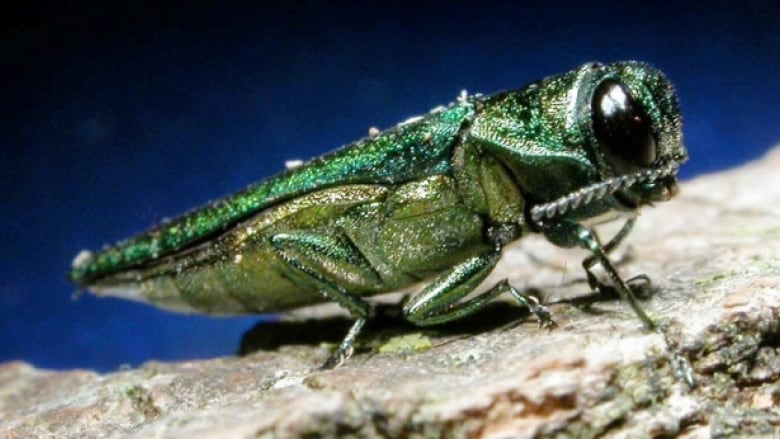Invasive emerald ash borer confirmed in Edmundston, a 1st for Atlantic Canada
CFIA has restricted movement of ash materials and other firewood to prevent spread of destructive beetle

The emerald ash borer, an invasive beetle that has destroyed millions of ash trees in parts of North America, has made its way to Atlantic Canada for the first time, with a confirmed presence in Edmundston.
The Canadian Food Inspection Agency will be conducting survey work with other government partners to determine how established and widespread the infestation is in the northern New Brunswick city.
In the meantime, CFIA has restricted the movement of all ash materials, such as logs, branches and woodchips, as well as all types of firewood from the affected area to help slow the spread.
The emerald ash borer poses a "major economic and environmental threat to urban and forested areas of North America," CFIA said in an advisory.
Anyone who violates the restriction could face fines and prosecution, it warns.
- Natural Resources Canada on the hunt for invasive species
- Fredericton working to avoid invasion of ash tree pest
Until now, the flying beetle, which has an emerald green back and bright green underbelly, was known to be present only in parts of Manitoba, Ontario, Quebec and the United States.
It's native to China and eastern Asia, but has been in Canada since at least 2002, said Jon Sweeney, a research scientist with the Canadian Forest Service at the Atlantic Forestry Centre in Fredericton.
'Smorgasborg of trees'

The emerald ash borer feeds on ash trees in Asia too, but they have developed natural defences because they "co-evolved" with the beetle, he said.
In North America, the beetle has "found a smorgasborg of trees that it can colonize, breed up in and do very well."
A tree can be destroyed within two to five years, depending on the number of beetles and larvae, said Sweeney, who specializes in the ecology and management of forest insect pests, primarily wood-boring beetles.
Within 10 years of the insect establishing in an area, "99 per cent of the native ash trees are dead."
Warning signs

The bug can be difficult to detect during the early stages of infestation, when populations are low, said Sweeney.
One sign to watch for is cracks in the bark.
The beetles lay their eggs on the tree trunk or branches and the larvae bore through to feed on the inner bark and outer sapwood. Peeling back the bark will reveal telltale flat and wide S-shaped galleries, he said.
When the beetles emerge, they leave D-shaped exit holes. Immature beetles feed on the foliage, creating irregular notches in the leaves.
CFIA inspectors, City of Edmundston employees, and officials from the New Brunswick Department of Energy and Resource Development and the Canadian Forest Service will work together on assessing and managing the infestation, said Sweeney.
Infested trees may need to be destroyed before the beetles emerge, he said. Trees that are not infested, or are in the early stages will need to be protected with a special insecticide that's injected into the tree.
With files from Matthew Bingley